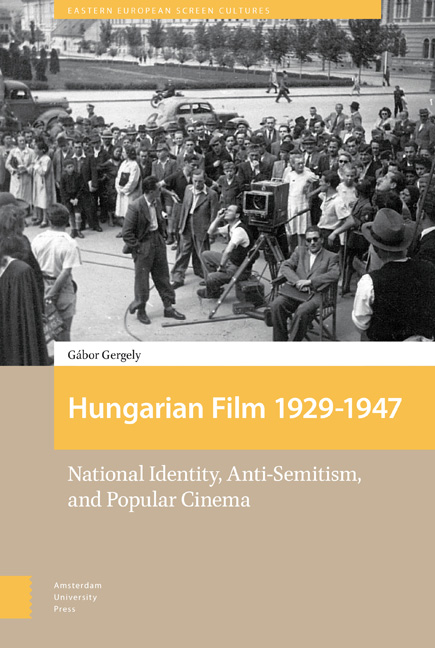Book contents
- Frontmatter
- Dedication
- Contents
- List of Illustrations
- Acknowledgements
- A Note on Accents, Pronunciation, Names, and Spellings
- Preface
- Introduction
- 1 Key Concepts in Pre-1945 Hungarian Cinema
- 2 A Contested Film History
- 3 An Industry Emerges 1931-1935
- 4 Boom, Crisis and Anti-Semitic Reorganization 1936-1941
- 5 From War Boom to Bust 1941-1944
- Epilogue: Industry Reboot and the Myth of a New Start 1945-1947
- Concluding Remarks
- Bibliography
- Index
2 - A Contested Film History
Published online by Cambridge University Press: 11 December 2020
- Frontmatter
- Dedication
- Contents
- List of Illustrations
- Acknowledgements
- A Note on Accents, Pronunciation, Names, and Spellings
- Preface
- Introduction
- 1 Key Concepts in Pre-1945 Hungarian Cinema
- 2 A Contested Film History
- 3 An Industry Emerges 1931-1935
- 4 Boom, Crisis and Anti-Semitic Reorganization 1936-1941
- 5 From War Boom to Bust 1941-1944
- Epilogue: Industry Reboot and the Myth of a New Start 1945-1947
- Concluding Remarks
- Bibliography
- Index
Summary
Despite the existence of a virtually complete corpus, and despite its ready availability on DVD, on TV, and in the cinemas, and, in infringement of copyright laws, on video-streaming sites, Hungarian filmmaking in the 1930s and 1940s is relatively under-researched. There is no English-language work tackling this exact period. Frey's Jews, Nazisandthe Cinema of Hungary has been long in the writing, and is yet to be published after repeated delays. Shorter accounts are found in Cunningham (2004a), Frey (2002; 2005; 2011), and Manchin (2012a; 2012b; 2013). Liehm and Liehm (1977), Hames (2004), and Bingham (2011) have included discussions of individual films in broad overviews of Central and Eastern European cinemas. What they all share is a reliance on the work of the Communist era historian István Nemeskürty (1965, 1974, 1980, etc.).
Hungarian scholarship can be divided into four main groups: contemporary accounts of Hungarian filmmaking published in the state-funded trade paper Magyar Film (1939-1944), and in academic publications by pioneering film scholars (1900-1944); Communist-era historiography (1949-1989); post-Communist scholarship (1989 onwards); and non-academic revisionist histories of Hungarian film typically published after the turn of the millennium. I begin with remarks on the four strands of Hungarian film historiography, before moving on to discuss English-language scholarship.
Contemporary Commentators
The groundbreaking film historian Miklós Kispéter (1938), and the formidable film technician, historian, and theorist Ferenc Lohr (1941) were most interested in the legitimacy of film as an art form (Kispéter 1938, 5-15; 195-237), the credibility of Hungary as a producer of film art, and the country's position in the global filmmaking economy (Lohr 1941, 162). Kispéter, Lohr, Dáloky (1942), and their contemporaries (Fejős, Castiglione, Hevesy, Gró, Váczi, Németh, et al. as reprinted in Kőháti 2001), expressed pride in the national industry's output, but also lamented the relative weakness of the sector compared to the capital-rich industries of the West. Reams of newsprint were produced by the Magyar Film staff on this subject.
Hungarian observers and critics saw film as an area of cultural and economic competition. For them, the development of a film industry and the quality of a nation's film output were measures of a nation's level of civilization. Every aspect of Hungarian film was presented in relation to foreign film economies.
- Type
- Chapter
- Information
- Hungarian Film, 1929–1947National Identity, Anti-Semitism and Popular Cinema, pp. 73 - 98Publisher: Amsterdam University PressPrint publication year: 2017



